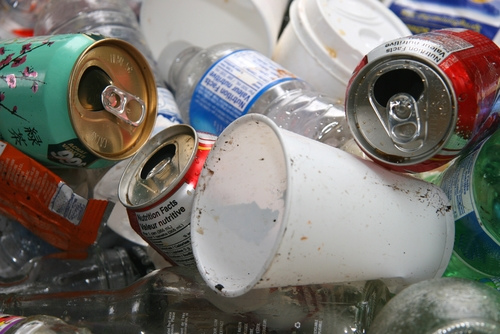 Where is “away”? That’s the question I asked my Environmental Sustainability students today. When you throw something away, where does it go? Here were some of the answers they wrote down:
Where is “away”? That’s the question I asked my Environmental Sustainability students today. When you throw something away, where does it go? Here were some of the answers they wrote down:
“Away is throwing your stuff across town to a junkyard.”
“Your trash gets burned.”
“Away is a big hole that is dug in the ground.”
“Out of St Louis, somewhere.”
“Away is the landfill.”
When asked about what a landfill is, most of my teenage students have no idea. It was a mythical idea in their minds, not an actual, physical place. I told them that each of them produces, on average, 4.5 pounds of trash per day, they couldn’t believe it. We then brainstormed what you might find in their household trash on any given day. More than half of the items they listed were easily recyclable.
It’s easy, when teaching kids about sustainability, to focus solely on energy. It’s what is in the media, it’s the hot topic. But solid waste issues, that is, issues that deal with our trash, are closely linked with energy. All that trash is produced using resources, including energy. Recycling projects are, in a sense, energy projects, because recycling (despite what many so-called recycling “mythbusters” might say) saves energy in the long run. As a whole, products made using “virgin” materials take exponentially more resources to develop than those made using recycled content. Not only that, but our addiction to disposal takes up land in the form of landfills and produces pollution in the form of methane and leachate (i.e. “trash juice”) that can seep into water supplies.
During this unit, I will do many things that will allow my kids to explore their solid waste impact. I will give each student a bag, and they will collect all of their waste (minus toilet paper and other personal hygiene waste) over a 24-hour period. They will then sort, weigh, and analyze what they are throwing away on a given day. We will talk about composting and food wastes. We will look at models for recycling, how recycling works, and recycling options in our area. We will look at source reduction, how students can choose products with less packaging, and how current packaging can be reimaged. We will examine the idea of “cradle-to-cradle” products. Students will examine the contents of our school trash and propose ways of reducing our solid-waste impact as a school community. We’ll also looks at methods of reuse, such as web-based communities like Freecycle or Gigoit.
Hopefully, we’ll be visiting a landfill so my kids can see firsthand the volume of trash that is created by St. Louisans on a daily basis. I have done this before several times, and it is truly an eye-opening experience to see the constant line of trucks filled with the daily castoffs of the greater St Louis area. Most landfills do school tours, so this might be something you want to check out for your child’s class.
The thing about trash is that we all have a connection to it. Almost all of us create a staggering amount of it, but upwards of 80% of what goes into landfills can be reduced, reused, or recycled. Just like any part of learning about green living, getting people to think critically about the impact of their actions is key.
[This post was written by Kelli Best-Oliver]
I completely agree that we should start teaching kids about trash, recycling, conservation and the wider world around them. All of their choices to keep the earth safe will be easy and automatic to them as they grow older.
Recently my mummy was watching my 4 year old son. He ate a package of Dots Halloween candy and then proceeded to break down the small paerboard box and place it in the paper recycling bag. My mom called me hysterically laughing at what a little green boy has was. While I was thinking that he was more of an earth activist at 4 then my mummy was at 58.
Sometimes you can’t teach an old dog new tricks.
Both the school and parents should be involved in teaching their kids about recycling and conservation. My kids are very good and understand what it is all about. Our local council does help by providing suitable containers to assist with collection – blue bins for paper, plastic and tins and green bin for glass bottles. If you make life a bit easier for people to collect they are more likely to do it.
“Teaching Kids About Trash” The material not the Band.
There needs to be an effort made to “Teach Adults About Trash.” They’re the group that is resposible for what’s done with it.
Everyone knows what “trash” or “garbage” is when they see it. The question should be: What is “humanity” going to do in “our lives” with the never stopping the production of garbage.
The $10,000 question seems to be; What determines when something man-made should be “thrown-away?” And where is “away?” “Just so it’s not in my back yard!”
Thank you
Chaz
I don’t see what the big deal is. A landfill is the place for trash. Why go through all that extra work to recycle trash.